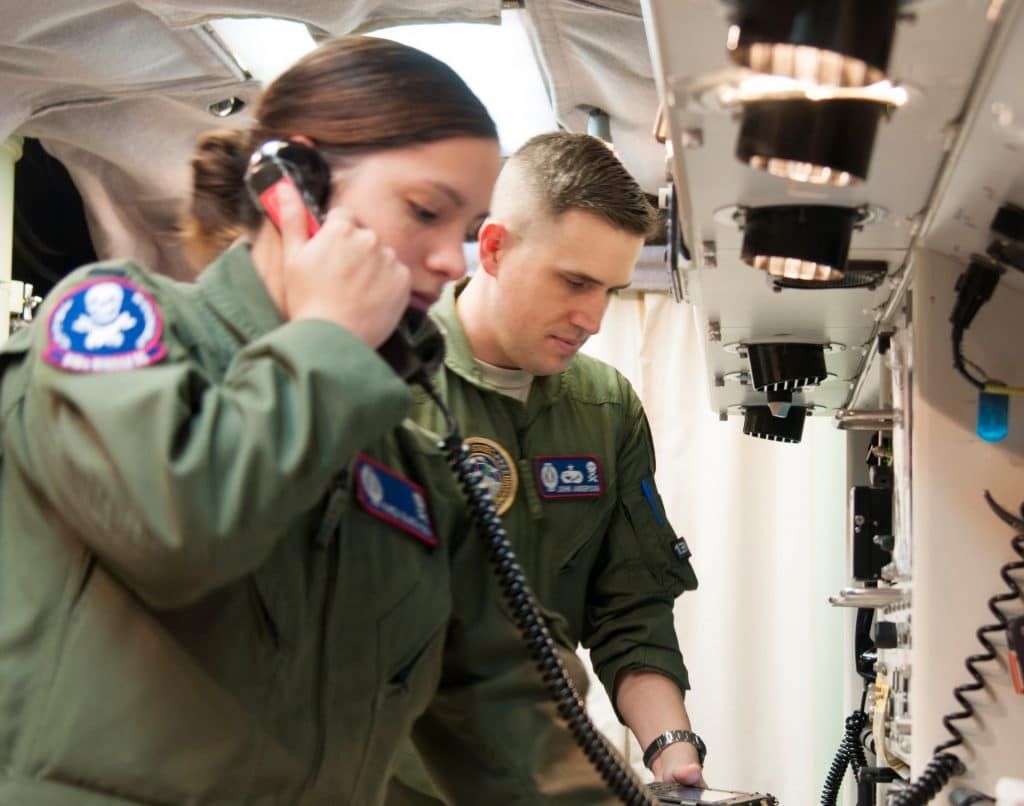How nuclear forces worldwide are dealing with the coronavirus pandemic
By John Krzyzaniak | April 14, 2020
 Members of the 319th Missile Squadron at a launch control center at F.E. Warren Air Force Base, Wyoming, 2016. US Air Force photo by Senior Airman Jason Wiese.
Members of the 319th Missile Squadron at a launch control center at F.E. Warren Air Force Base, Wyoming, 2016. US Air Force photo by Senior Airman Jason Wiese.
In recent weeks, the coronavirus outbreak has elicited at least a few tone-deaf comments from top US defense officials about the readiness of their nuclear forces. In mid-March, the commander of US Strategic Command, Adm. Charles Richard, reassured his audience that the United States’ nuclear forces had not been adversely affected by the pandemic and that they “remain ready to execute the nation’s strategic deterrence mission.” In effect, Adm. Richard was telling his audience that the United States was still capable of launching a massive nuclear retaliation that would undoubtedly kill millions. Similarly, at the beginning of April, the commander of the US Air Force’s Global Strike Command told Popular Mechanics that, despite the COVID-19 outbreak, “its nukes are still ready to fly.” These officials were apparently oblivious to the notion that, with the pandemic already causing enough fear and dread on its own, now may not be the best time to remind the general public about other ways the world could end.
The rhetoric notwithstanding, the US nuclear mission and its analogues around the world rely heavily on people, and people are exactly what the virus is after. Just a few days after Adm. Richard gave his briefing, Newsweek reported that “units feeding [US Strategic Command] have a cumulative 106 uniformed personnel not on duty due to coronavirus, either because of confirmed cases or ‘protective self-quarantine.’” On April 9, Hans Kristensen, director of the Nuclear Information Project at Federation of American Scientists, tweeted that all US nuclear bases except one had confirmed cases of COVID-19.
All US nuke bases (except one) now have #coronavirus cases:
Barksdale AFB (bombers)
F.E. Warren AFB (bombers)
Kirtland AFB (storage)
Minot AFB (bombers/ICBMs)
Offutt AFB (NC3)
Whiteman AFB (bombers)
Kings Bay (SSBNs)
Kitsap-Bangor (SSBNs)https://t.co/6HbMUjGOZA @warkin pic.twitter.com/2YRrPp7Rpy— Hans Kristensen (@nukestrat) April 9, 2020
So, if the world’s nuclear forces have not already felt the strain caused by the pandemic, it is likely only a matter of time until they feel it. In fact, some countries are taking extra precautions to mitigate potential risks. But every country with nuclear weapons has a different calculus to make, and some aspects of these arsenals may be more vulnerable to the virus than others.
The weak points. The United Kingdom’s nuclear deterrent is based on a single platform, its submarines. In early April, the London Times reported that two of Britain’s four nuclear-armed submarines have been under repairs for the last year.
With only two operational submarines left, the British Royal Navy has almost no margin for error in dealing with the coronavirus. Sebastian Brixey-Williams, co-director of the London-based British American Security Information Council, cast the problem in stark terms. The Times report, he wrote, “poses profound questions about how prepared the [Royal Navy] is to cope with the COVID-19 pandemic. Were a Trident submarine to go on patrol only to find that one of its sailors had brought the virus aboard, the captain would have no option but to return to port or else risk the lives of the crew.” This, Brixey-Williams said, could bring about an unprecedented break in the United Kingdom’s round-the-clock deterrence mission, which, at least in theory, needs to be uninterrupted if it is to remain credible.
Of course, the United Kingdom has a backup: NATO. “Since the system sits within a wider NATO deterrence posture,” Brixey-Williams cautioned in an email, “this does not mean the United Kingdom should add more redundancy at great expense.”
The United Kingdom is not the only country whose navy is at risk. The United States, Russia, and France, all of which also rely to some degree on nuclear-armed ballistic missiles at sea, could face the same problem. However, the United States has 14 nuclear-armed submarines and Russia has 10, though some of those are under maintenance at any given time. Still, the relative effect of losing one boat to a coronavirus outbreak would be less acute for those countries. And France’s fleet, though it only has four nuclear-capable submarines, has not been beset by the same maintenance problems as the British fleet.
Tong Zhao, a senior fellow at the Carnegie Endowment for International Peace, told the Bulletin that China’s nuclear submarine fleet is also vulnerable to the virus. Compared to land-based missile forces and aircraft units, the submarines have a greater challenge both because of their inability to receive external support during deployment and because of their relative lack of operational experience. However, it is unknown whether Chinese submarines actually carry nuclear weapons on patrols and, as a general practice, China keeps its nuclear warheads separate from delivery vehicles during peacetime. As a result, China relies much less on the sea-based leg of its triad compared to the Western nuclear powers.
The pandemic threat to naval forces is not purely theoretical. France’s sole aircraft carrier, which plays a role in its air force’s nuclear strike missions, returned home on April 12 with at least 50 cases onboard the ship. Similarly, Forbes has reported that “the entire crew of a Russian [non-nuclear armed] submarine has reportedly been quarantined after indirect contact with a confirmed case of COVID-19.” And at least four different US aircraft carriers have reported COVID-19 cases onboard, including the much-publicized case of the USS Theodore Roosevelt, which has been forced to return to port in Guam and whose captain has been relieved from duty.
Another potential vulnerability for China stems from the fact that it keeps nuclear warheads in constant circulation between central storage at a base in the Qingling mountains and other locations. According to a 2010 report by Mark Stokes, a former US defense official and expert on Chinese nuclear forces, the regiment responsible for transporting the warheads “operates 24 hours a day, seven days a week to keep the warheads circulating” between the central storage complex and six smaller storage facilities at different missile bases. These could be the most crucial personnel to keep healthy if the country faces a second spike in cases.
For every country, the top of the chain of command is another potential point of failure. For instance, Prime Minister Boris Johnson, who has the sole authority in his government to authorize a nuclear strike, became the first world leader to test positive for the coronavirus on March 27, was hospitalized on April 5, and had to be moved to intensive care on April 6. It was only with this last development that he decided to put Dominic Raab, his foreign secretary, in charge of the government. Johnson “would very probably have handed on formal nuclear launch authority to … Dominic Raab (or, for whatever reason, another deputy),” at that time as well, said Brixey-Williams. (Johnson has since been released from the hospital, but has not yet returned to work.)
The precautions. However, it is probable, according to a 2019 report by nuclear experts Jeffrey Lewis and Bruno Tertrais, that the British prime minister would have designated several nuclear deputies within his government upon taking office to avoid the need to make such decisions during a crisis.
In fact, every nuclear-armed country has emergency devolution procedures—plans for who holds the nuclear button if the commander-in-chief suddenly becomes incapacitated. In many countries, these are kept secret, but in the United States it is the vice president who takes over for the president, while in Russia it is the prime minister, or, in certain emergency situations, the defense minister.
Beyond the routine precautions, governments are also taking more specific steps to head off risks to their nuclear forces.
In the United States, the Defense Department is scaling down and canceling some military exercises and deployments to focus on essential operations, Newsweek reported in March. For instance, a recent B-2 bomber mission to Europe was noticeably shorter than in prior years, according to Kristensen. He was careful to point out, however, that it was not clear whether the mission was officially shortened because of COVID-19.
For nuclear-armed submarines, some countries are putting their sailors into a 14-day pre-departure isolation. That way, any personnel who had contracted the virus would show symptoms and could be pulled from the crew before the boat began its two-month patrol at sea.
China’s Rocket Force, which controls the country’s land-based ballistic missiles, is taking precautions to fully maintain readiness levels as well. “One of the measures, for instance, is to train missileers to each master the skills for more than one position, so that the whole unit can still carry out missions with fewer than normal people on duty,” Zhao said.
Together, we make the world safer.
The Bulletin elevates expert voices above the noise. But as an independent nonprofit organization, our operations depend on the support of readers like you. Help us continue to deliver quality journalism that holds leaders accountable. Your support of our work at any level is important. In return, we promise our coverage will be understandable, influential, vigilant, solution-oriented, and fair-minded. Together we can make a difference.
Keywords: COVID-19, Coronavirus, SSBN, nuclear forces, nuclear submarines
Topics: Biosecurity, Nuclear Weapons
















The only way to fully mitigate the risks is to do what South Africa did after apartheid got abolished: dismantle the nukes. As Nelson Mandela put it, why does anyone need nuclear weapons?